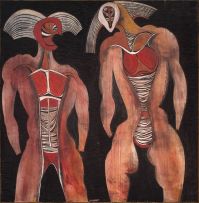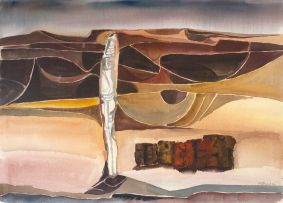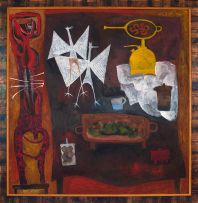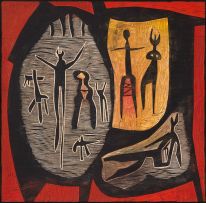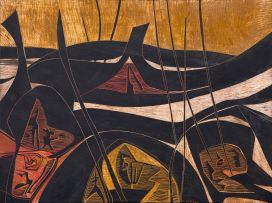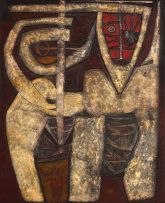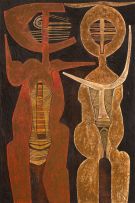Important South African and International Art, Decorative Arts & Jewellery
Live Auction, 5 March 2018
Art: Evening Sale
About this Item
signed
Notes
The 'Shaka Epic' spans approximately two years of Cecil Skotnes' production and begins with his reading of E A Ritter's text, Shaka Zulu. Around this same period in the early 1970s he was commissioned by collector, Vittorio Meneghelli, to carve a large wooden door consisting of 44 wooden panels which Skotnes used to tell the legend of Shaka Zulu.
Inspired by this epic tale, Skotnes teamed up with the poet Stephan Gray to embark on the portfolio The Assassination of Shaka, which was exhibited at the Goodman Gallery on 20 October, 1973. Undertaking extensive fieldwork which included traveling "the route from Shaka's birthplace to his Great Kraal", the portfolio - consisting of 43 plates - took 15 months to complete.1
This was due to Skotnes working concurrently on large woodcut panels which depicted characters from the saga of which the present lot is an example. The female figure that accompanies Shaka is possibly his mother, Queen Nandi, who appears in plate 5 of the portfolio. Thirteen of these large wooden panels, described by Frieda Harmsen as incised paintings, were then exhibited in May of 1974 at the Goodman Gallery along with preparatory drawings and watercolours.2
Describing his elevation of Shaka to the status of a mythological hero, Skotnes noted that "because of the medieval character of the woodblock technique… we get down to fundamentals, which is what Shaka was - a fundamental figure in South Africa's history. His is in fact, an epic of all Africa. Shaka matches the great mythological figures of the ancient world in every aspect of life and thus, in less than 150 years, we have a figure of this stature on the horizon of our history".3
- Frieda Harmsen (ed) 1996. Cecil Skotnes. Cape Town, Tricolor Press. Page 33.
- Ibid., page 34.
- Quoted in Denis Godfrey, "Shaka Comes to Life", The Star, 20 October 1973.
Exhibited
This work was on loan to the Oppenheimer Library, University of Cape Town, from 2001 - 2017, catalogue number 39.

